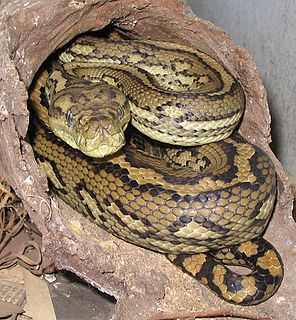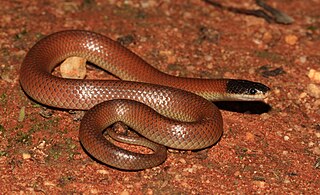
Morelia spilota, commonly referred to as the carpet python, is a large snake of the family Pythonidae found in Australia, New Guinea, Bismarck Archipelago, and the northern Solomon Islands. Many subspecies are described; ITIS lists six, the Reptile Database six, and the IUCN eight.

Dwyer's snake also known as the whip snake and the variable black-naped snake, is a species of venomous snake in the family Elapidae. The species is endemic to Australia, where it is found from New South Wales to South Queensland. While closely related to Australian sea snakes, P. dwyeri is a terrestrial reptile.

Suta is a genus of venomous snakes in the family Elapidae. The genus is endemic to mainland Australia.

The curl snake is a species of venomous, heavily built snake in the family Elapidae. The species, which is native to Australia, is also known more commonly in Western Australia as the myall snake. The curl snake is often confused with a similar species named the Ord curl snake.
The Hamersley Range spotted gehyra is a species of gecko in the genus Gehyra. It is endemic to Western Australia. It was first described in 2018.
The monk snake, also known commonly as the hooded snake, is a species of venomous snake in the family Elapidae. The species is native to central and western Australia.

The Mallee black-backed snake, also known commonly as the black-backed snake, the copper snake, and Mitchell's short-tailed snake, is a species of venomous snake in the family Elapidae. The species is endemic to Australia.

The little whip snake, also known commonly as the whip hooded snake, is a species of venomous snake in the family Elapidae. The species is endemic to Australia.

The spectacled hooded snake, also known commonly as the Port Lincoln snake, is a species of venomous snake in the family Elapidae. The species is native to central-southern Australia. There are three recognized subspecies.
Gould's hooded snake, also known commonly as the black-headed snake, is a species of venomous snake in the family Elapidae. The species is endemic to Western Australia.

The saltbush Morethia skink, or more commonly referred to as saltbush skink, is a species of skink found in Australia. They are part of an 8 species genus of Morethia, which are all endemic to Australia. Akin to other members of the Morethia genus, saltbush skinks feature transparent disks as eye covers and eyelids which are stationary, along with specialised limbs which enable quick traversal of sand dunes. Taxonomically, the species was first classified by German explorer Wilhelm Karl Hartwig in 1871.
Brachyurophis approximans, also known as the north-western shovel-nosed snake, is a species of venomous burrowing snake that is endemic to Australia. The specific epithet approximans (“approaching”) alludes to its similarity to Brachyurophis campbelli.
Suta minimus, also known as Rosen's snake, is a species of venomous snake that is endemic to Australia. The specific epithet fasciata (“banded”) refers to the body markings.
Suta gaikhorstorum, also known as the Pilbara hooded snake, is a species of venomous snake that is endemic to Australia. The specific epithet gaikhorstorum honours naturalists Klaas and Mieke Gaikhorst of the Armadale Reptile & Wildlife Centre.
Cryptophis nigrostriatus, also known as the black-striped snake, is a species of venomous snake native to Australia and New Guinea. The specific epithet nigrostriatus (“black-striped”) refers to its body markings.

Cryptophis pallidiceps, also known as the western Carpentaria snake or northern small-eyed snake, is a species of venomous snake endemic to Australia. The specific epithet pallidiceps (“pale-headed”) refers to its body markings.
Anilios ammodytes, also known as the sand-diving blind snake, is a species of blind snake that is endemic to Australia. The specific epithet ammodytes (“sand-diver”) refers to the snake's habits and habitat.
Anilios ganei, also known as Gane's blind snake, is a species of blind snake that is endemic to Australia. The specific epithet ganei honours schoolteacher and amateur herpetologist Lori Gane who collected the first known specimen in 1991.
Anilios longissimus, also known as the extremely long blind snake, is a species of blind snake that is endemic to Australia. The specific epithet longissimus refers to the snake's size and appearance.








